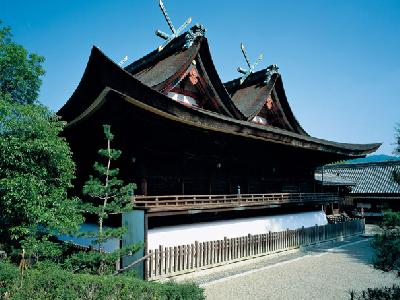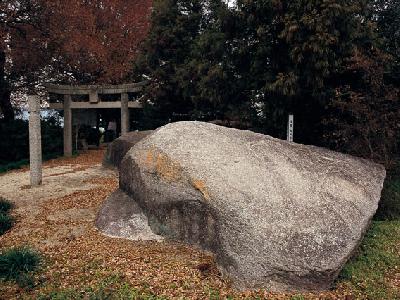|
Kamadono Hall is part of Kibitsu Shrine in Okayama and is designated as an important national cultural asset.
Kamadono Hall is also popular for a peculiar fortune-telling ritual involving a 'kami' (a large metal cauldron) standing on a 'kamado' (a cooking range with a place for fire underneath). In the hall, people seeking to know their fortune, place offerings such as sacred sake in front of the cauldron and pray to the oracle. The fire below keeps the cauldron hot. If the cauldron produces a loud sound, it represents 'good fortune'; if it stays silent or creates a soft sound, it means 'misfortune'.
There is a legend that the head of the ogre Ura (the origin of the Oni demon) is buried under the kamado. Akinari Ueda in the 'Ugetsu' relates the story that, one night, Prince Kibitsuhiko (the model for Momotaro, the legendary Peach Boy) dreamt of Ura's spirit, which tells the prince to have his wife Azome light the fire beneath the cauldron. The spirit says that a 'rich' sound from the cauldron will bring good fortune, while a 'wild' sound will bring misfortune.
From this legend, we can clearly see how Kibitsuhiko's dream became part of the fortune-telling narukami ritual we see today at the shrine.
Kamadono Hall is also popular for a peculiar fortune-telling ritual involving a 'kami' (a large metal cauldron) standing on a 'kamado' (a cooking range with a place for fire underneath). In the hall, people seeking to know their fortune, place offerings such as sacred sake in front of the cauldron and pray to the oracle. The fire below keeps the cauldron hot. If the cauldron produces a loud sound, it represents 'good fortune'; if it stays silent or creates a soft sound, it means 'misfortune'.
There is a legend that the head of the ogre Ura (the origin of the Oni demon) is buried under the kamado. Akinari Ueda in the 'Ugetsu' relates the story that, one night, Prince Kibitsuhiko (the model for Momotaro, the legendary Peach Boy) dreamt of Ura's spirit, which tells the prince to have his wife Azome light the fire beneath the cauldron. The spirit says that a 'rich' sound from the cauldron will bring good fortune, while a 'wild' sound will bring misfortune.
From this legend, we can clearly see how Kibitsuhiko's dream became part of the fortune-telling narukami ritual we see today at the shrine.
| [+ADDRESS] | 
|
















